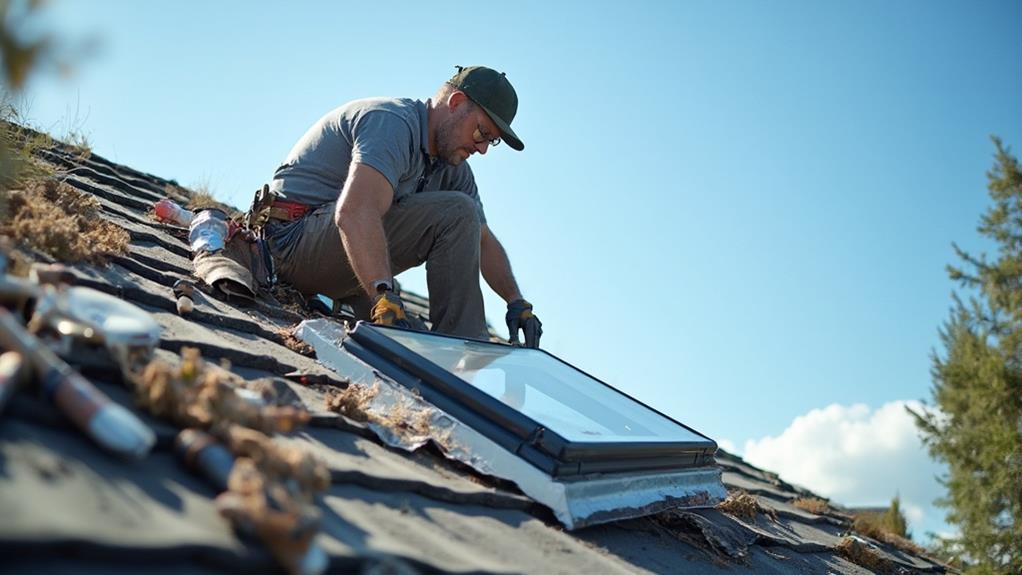When you're considering installing skylights, it's crucial to approach the project with care to avoid damaging your roof. You'll want to start by assessing your roof type and ensuring it's in solid condition. Selecting the right skylight and planning its placement can make a significant difference in both aesthetics and functionality. As you gather your tools and prepare the area, you'll discover that each step requires attention to detail. But before you proceed with cutting the roof opening, let's explore some essential techniques that can help safeguard your roof during installation.
Assessing Your Roof Type
When considering installing skylights, it's crucial to assess your roof type first. Different roof materials, such as asphalt shingles, metal, or tile, significantly impact how you approach the installation. Each material has specific characteristics that can affect water drainage and insulation, so understanding these is essential to ensure a successful skylight installation.
Next, you need to evaluate the slope of your roof. Roofs with steeper slopes may require specialized flashing techniques to prevent leaks, while flatter roofs can pose challenges with water accumulation. If your roof's pitch is too low, you might need to consider additional waterproofing measures to avoid moisture issues.
Additionally, the orientation of your roof affects sunlight exposure and, consequently, the type of skylight you choose. For example, south-facing slopes receive more sunlight, making them ideal for maximizing natural light, but they also require careful consideration of heat gain.
Choosing the Right Skylight
Choosing the right skylight is essential for enhancing both the functionality and aesthetics of your space. Start by considering the energy efficiency of the skylight. Look for models with double or triple glazing, as these can significantly reduce heat loss and improve insulation.
Additionally, consider the type of glazing; low-emissivity (Low-E) glass is particularly effective in minimizing UV rays while maximizing natural light.
Next, think about design aesthetics. You'll want a skylight that complements your existing architecture and interior decor. Flat, domed, and tubular skylights each offer unique visual impacts and practical benefits.
For instance, tubular skylights are ideal for smaller spaces, as they provide ample light without taking up much room.
Also, consider the placement of your skylight. A well-placed skylight can highlight architectural features and enhance the overall ambiance. Be mindful of potential glare and heat gain, especially in south-facing installations.
Ultimately, selecting the right skylight involves balancing energy efficiency with your design preferences, ensuring you create a bright, inviting space that meets your needs.
Gathering Necessary Tools
Before you start installing your skylight, you need to gather the essential tools and safety gear.
Make sure you have items like a tape measure, level, and roofing nails ready, along with appropriate personal protective equipment.
This preparation is crucial to ensure a smooth and safe installation process.
Essential Tools Required
Gathering the essential tools is crucial for a successful skylight installation. First, you'll need a measuring tape to accurately assess the area where you'll install the skylight. This helps determine the appropriate skylight types for your project.
A chalk line will assist you in marking precise cut lines on your roofing material.
Next, have a reciprocating saw ready for cutting through shingles and roofing sheathing. Depending on your installation techniques, a circular saw may also be useful for larger cuts.
You'll require a hammer and roofing nails or screws for securing the skylight frame into place. Additionally, a level ensures that your skylight is properly aligned, preventing potential leaks.
Don't forget a caulking gun and waterproof sealant, which are essential for sealing around the skylight to protect against water intrusion.
A pry bar can help you remove old shingles without damaging the surrounding area. Lastly, having a utility knife on hand will assist in trimming any excess materials.
With these tools gathered, you'll be well-equipped to tackle your skylight installation effectively.
Safety Gear Needed
When installing skylights, prioritizing safety is essential to ensure a smooth and accident-free process. To achieve this, you need to gather the right safety gear.
Start with a hard hat to protect your head from potential falling objects or accidental bumps. Safety goggles are crucial as they shield your eyes from debris while cutting or drilling.
Next, invest in a reliable safety harness and lanyard for fall protection. Attach the harness to a secure anchor point on your roof to minimize the risk of falls. Additionally, non-slip footwear will provide better traction while working on the roof's surface.
Ladder safety is another key component of your safety gear. Use a sturdy, rated ladder that's tall enough for your project, and ensure it's placed on a stable, flat surface. Always maintain three points of contact when climbing or descending.
Lastly, consider using knee pads, as they can protect your knees while you work on the roof.
Planning the Installation Location
Choosing the right location for your skylight is crucial to maximizing natural light and energy efficiency in your home. Start by assessing the areas that receive optimal sunlight throughout the day.
Ideally, you'll want to install your skylight on a south-facing roof to capture the most light, but consider how the sun's angle changes with the seasons.
Next, think about aesthetic considerations. The skylight should complement your home's architecture and interior layout. For instance, placing it above a central space, like a living room or hallway, can create an inviting atmosphere while enhancing the overall design.
Evaluate any potential obstructions, such as trees or neighboring buildings, that might block sunlight. It's also important to consider the roof slope and structure to ensure proper installation and drainage.
Lastly, factor in the purpose of the skylight. If you're aiming to illuminate a workspace or create a cozy reading nook, position it accordingly.
Preparing the Roof Area
Before you begin the installation of your skylight, it's essential to prepare the roof area to ensure a successful project. Start by inspecting the roof structure for any signs of damage or decay. Look for weak spots, rotting wood, or sagging areas that could compromise the integrity of the installation. If you find any issues, address them before proceeding.
Next, consider the weather conditions in your area. It's best to schedule your installation during dry weather to avoid complications like leaks or moisture intrusion. If rain or high winds are forecasted, postpone the project until conditions improve.
You should also clean the roof area thoroughly, removing debris, leaves, and dirt that could interfere with the installation process. Use a broom or leaf blower for this task.
Additionally, confirm that you have adequate safety equipment in place, such as harnesses and stable ladders, to protect yourself while working on the roof.
Cutting the Roof Opening
Before you cut the roof opening for your skylight, gather the necessary tools, such as a circular saw, measuring tape, and safety glasses.
It's crucial to follow safety precautions, including wearing protective gear and ensuring the area is clear of debris.
With the right preparation, you can proceed confidently and accurately.
Tools Needed for Cutting
When cutting the roof opening for your skylight, you'll need a specific set of tools to ensure accuracy and safety. Using the right tools not only streamlines the process but also minimizes the risk of damage.
Here's a list of essential tools you should have on hand:
- Circular Saw: Ideal for making precise cuts through roofing materials.
- Reciprocating Saw: Perfect for navigating tight spaces and making detailed cuts.
- Measuring Tape: Accurate measurements are crucial for determining the correct skylight size.
- Utility Knife: Useful for trimming shingles and other materials before the main cutting.
Ensure you maintain your tools properly; sharp blades and well-functioning equipment will yield better results.
Familiarize yourself with effective cutting techniques to enhance your efficiency. A clean and well-maintained toolset can significantly reduce the likelihood of making errors during the cutting process.
With the right tools and preparation, you'll set the stage for a successful skylight installation.
Safety Precautions to Follow
Cutting the roof opening for your skylight requires a keen focus on safety to prevent accidents and injuries. Before you start, ensure you have the right personal protective equipment (PPE), including gloves, safety goggles, and a hard hat.
Ladder safety is crucial when working at heights. Always place your ladder on a stable, level surface and extend it three feet above the roof edge for secure access. Secure the ladder with stabilizers if necessary, and never lean too far to one side while cutting; maintain your center of gravity.
Consider using fall protection systems, such as harnesses and safety lines, especially if you're working on a steep or high roof. If your roof pitch is too steep for comfortable access, it's wise to hire a professional.
Before cutting, double-check the area beneath your work zone for any hazards. Keep your workspace organized and free of debris to minimize tripping risks.
When you're ready to cut, use the appropriate tools, and make sure you're steady and focused. Following these precautions will help ensure a safe and efficient skylight installation process.
Installing the Skylight Frame
To successfully install the skylight frame, start by ensuring that you have the right tools and materials on hand, including a level, measuring tape, and appropriate fasteners.
Proper frame construction is vital to the integrity of your skylight installation. Follow these steps for a precise setup:
- Measure the Opening: Confirm that the dimensions of the skylight materials match the framing area. Accurate measurements prevent gaps and ensure a snug fit.
- Cut the Frame: Using your measurements, cut the frame materials to size. Be sure to use a level to maintain even cuts, which is crucial for proper alignment.
- Attach the Frame: Secure the frame to the roof structure using appropriate fasteners. Ensure it's flush against the roof to prevent any future leaks.
- Check for Level: After attaching, use your level again to confirm the frame is perfectly horizontal. This step is essential for effective drainage and overall functionality.
Sealing and Waterproofing
Proper sealing and waterproofing are crucial for the longevity and efficiency of your skylight installation. After securing the skylight frame, you need to ensure that water won't penetrate your roof.
Start by applying appropriate flashing techniques around the edges of the skylight. Flashing directs water away from the installation and prevents leaks. Consider using self-adhesive flashing tape for a reliable seal that's easy to work with.
Next, choose the right sealant options. Silicone-based sealants are popular due to their durability and flexibility, making them ideal for extreme weather conditions.
You'll want to apply the sealant along the edges of the flashing and the skylight to create a watertight barrier. Make sure to follow the manufacturer's instructions for the specific sealant you choose, as curing times can vary.
Final Inspection and Maintenance
Conduct a thorough final inspection to ensure your skylight installation meets all safety and performance standards. This crucial step helps you identify any issues before they escalate into costly problems.
Once the installation is complete, here are key areas to focus on during your final inspection:
- Check Seals and Flashing: Ensure all seals are intact and flashing is properly installed to prevent leaks.
- Inspect Interior for Water Damage: Look for signs of water stains or dampness around the skylight, indicating potential leaks.
- Examine the Skylight Structure: Confirm that the skylight frame is secure and free from any structural defects.
- Test Operation: If your skylight is operable, test its opening and closing mechanisms for smooth operation.
After the final inspection, establish a routine maintenance schedule to prolong the lifespan of your skylight. This should include cleaning the glass, checking seals, and ensuring that surrounding roofing materials are in good condition.
Regular maintenance not only enhances performance but also helps maintain the aesthetic appeal of your home. By staying proactive, you can avoid future issues and enjoy the benefits of natural light in your space.







